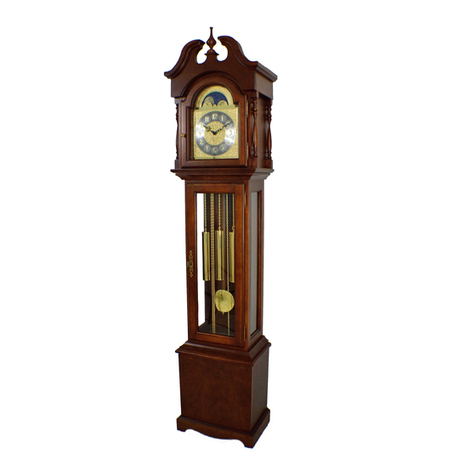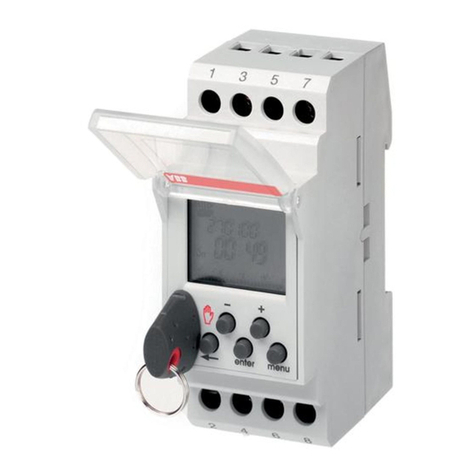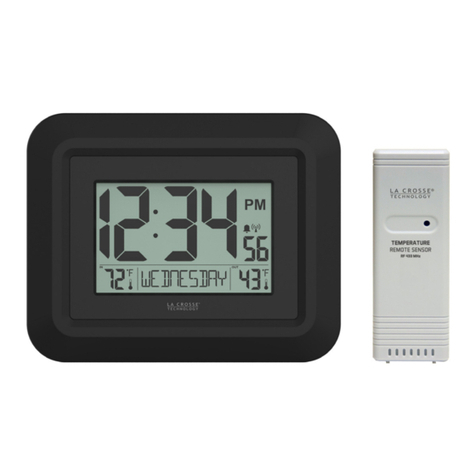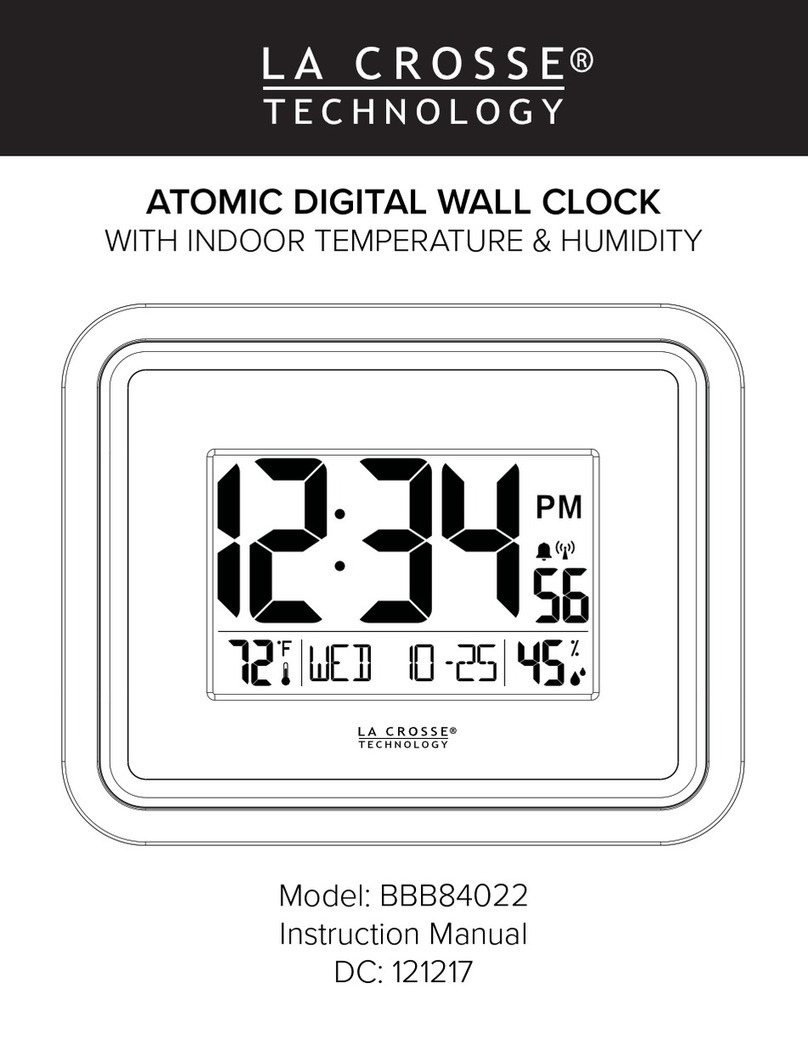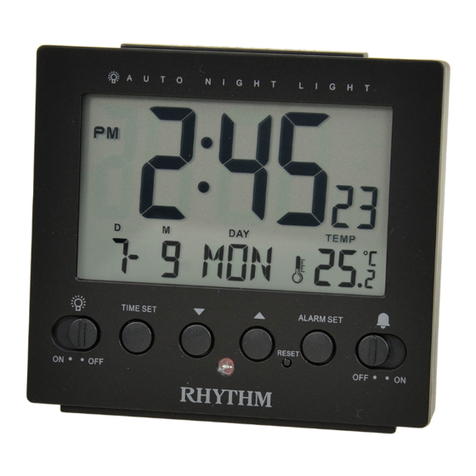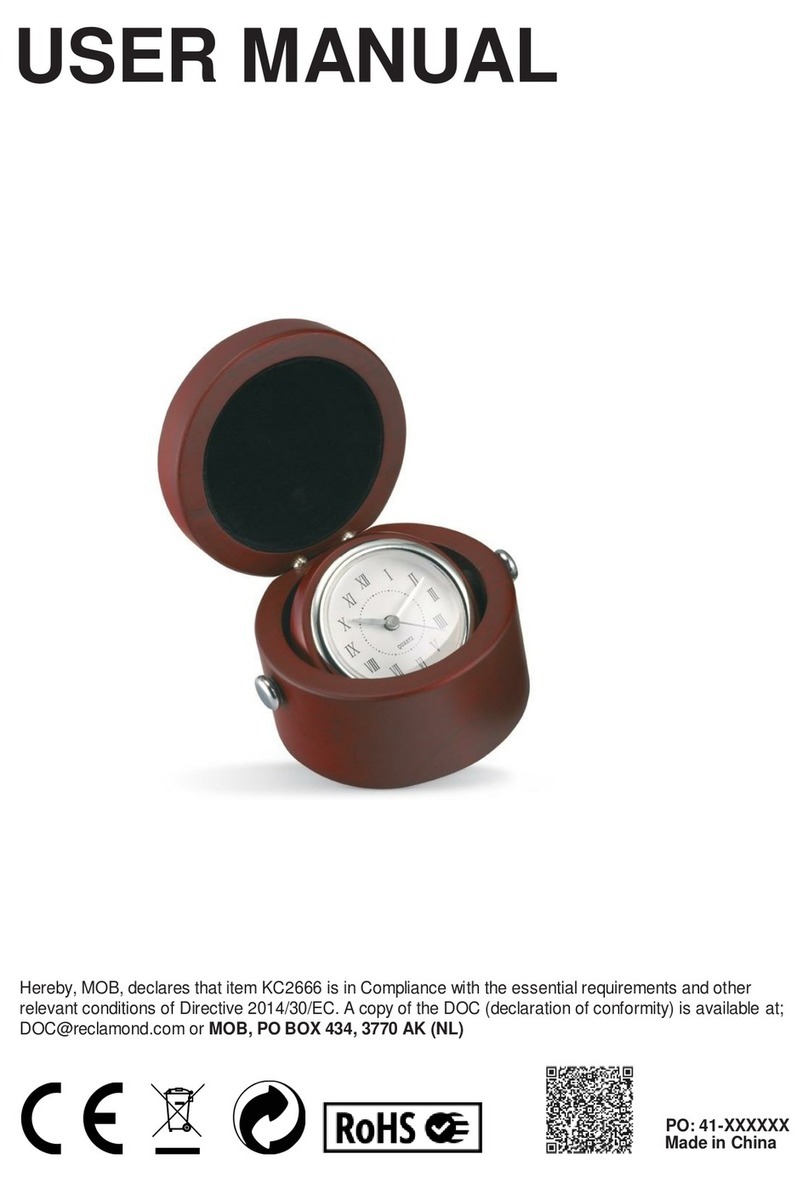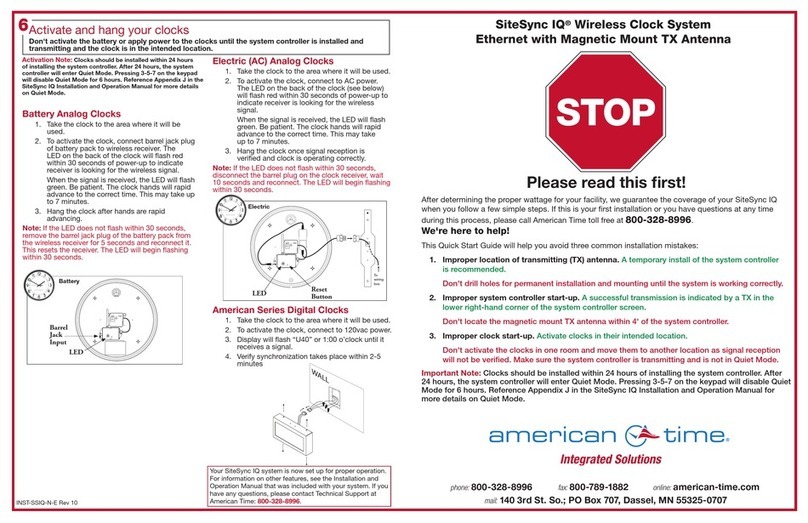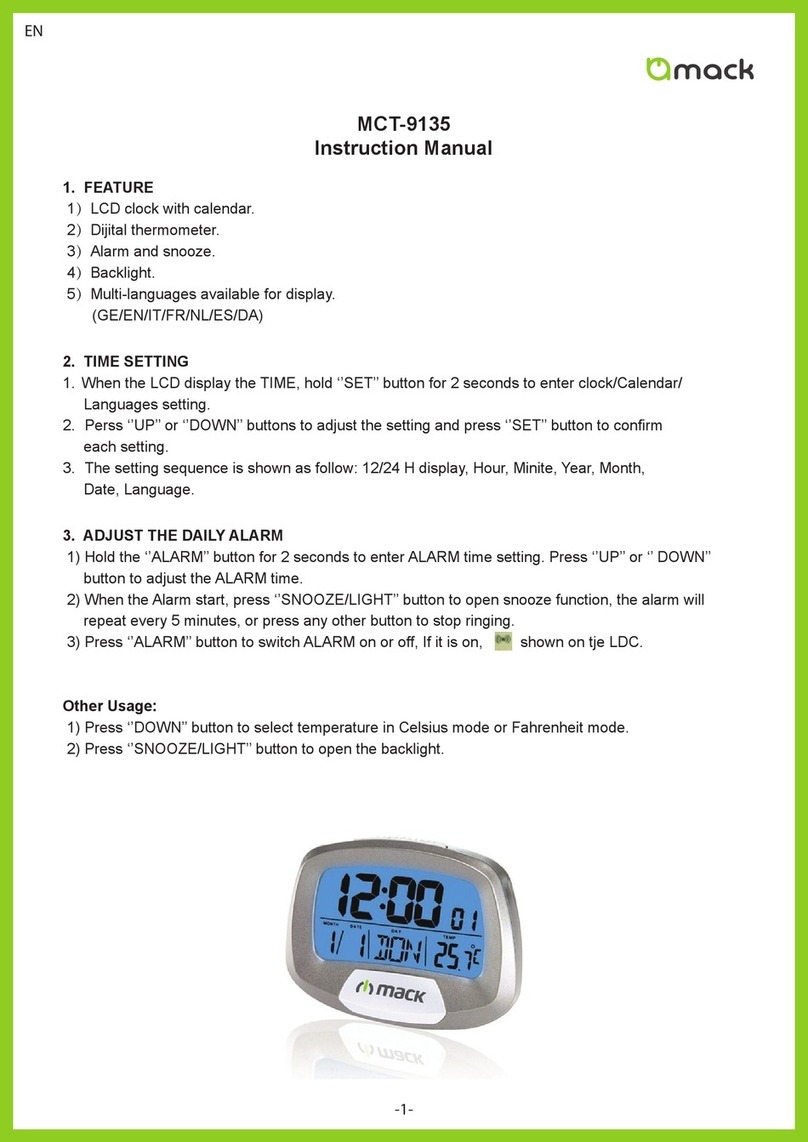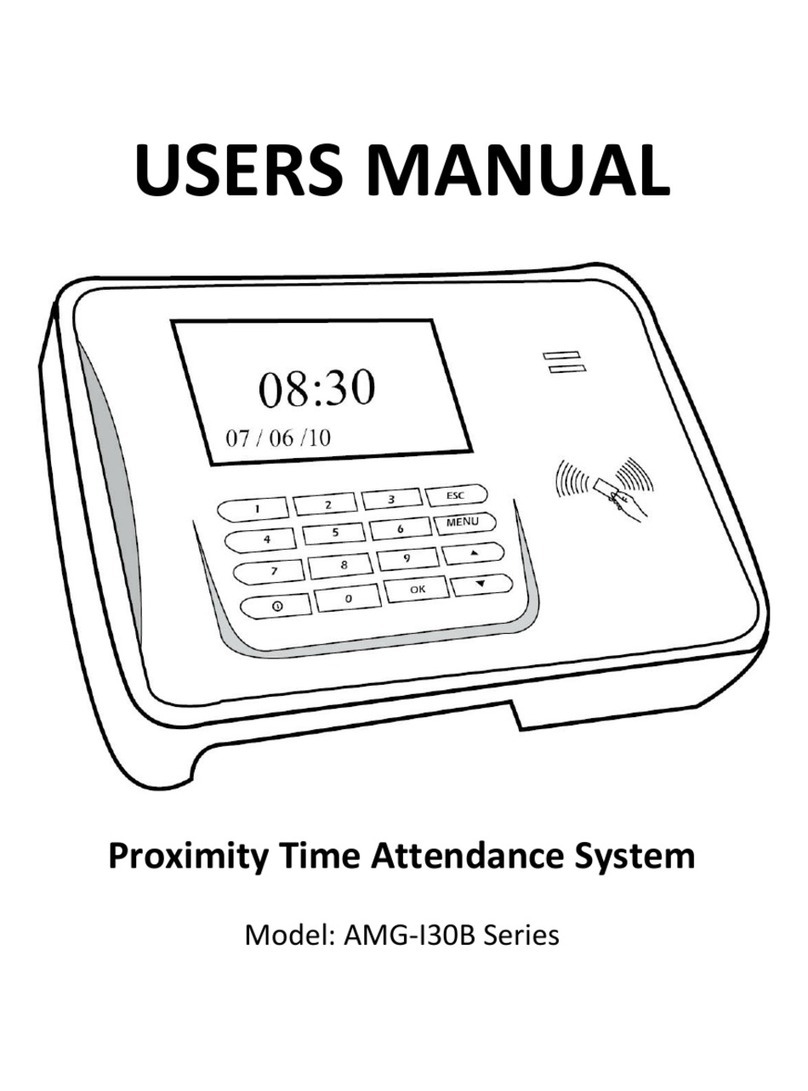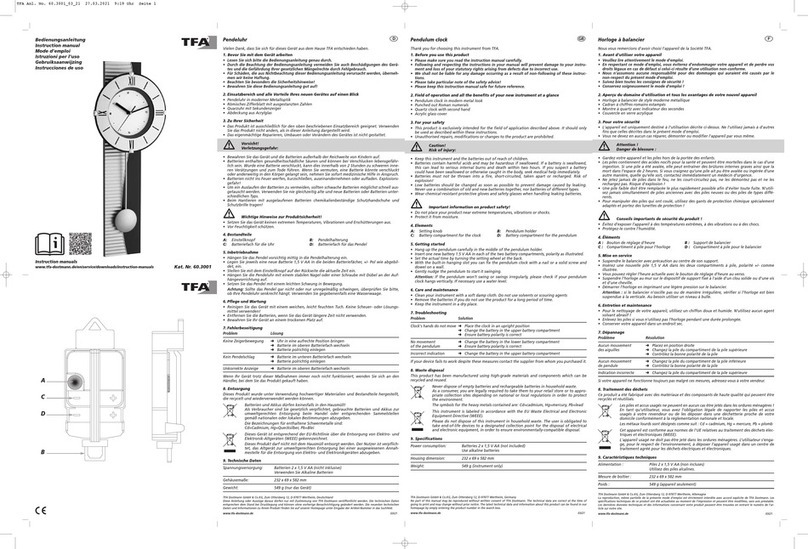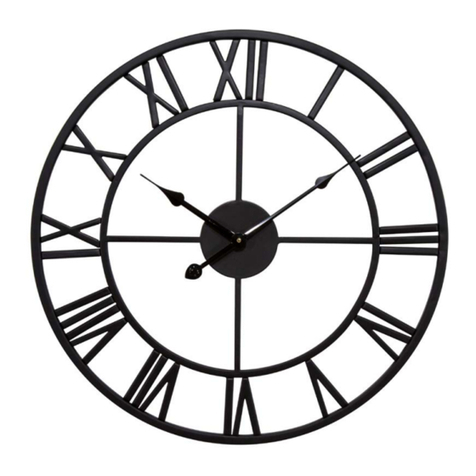Emperor Clock Company 100 M Movement Manual

Model
100
M
Movement
Copyright
1974
Emperor
Clock
Co.
All
Rights
Reserved
On
this
and
the
following
pages
you
will
find
specifications,
installation
instructions,
proper
operation
and
trouble
shooting
information
to
assure
you
satisfaction
with
your
Emperor
Grandfather
Clock
Movement,
now
and
in
the
future.
The
Emperor
Movement,
designed
and
manufactured
to
West
German
specifications,
provides
a
beautiful,
melodicus
sound
on
the
eight
balanced
and
musically
tuned
chime
rods.
Our
clocksmiths
have
made
a
thorough
and
complete
check
of
your
movement
in
their
modern,
humidity
controlled
rooms
that
also
contain
a
complete
inventory
of
all
parts
used
and
the
finest
in
clock
test
equipment.
We
invite
you
to
visit
our
plant
when
you
come
to
the
Fairhope
area,
located
on
beautiful
Mobile
Bay,
50
miles
west
of
Pensacola,
Florida
and
25
miles
east
of
Mobile,
Alabama.
Emperor
Industrial
Park,
Fairhope,
Alabama
36532.
SPECIFICATIONS
SIZE
OF
DIAL
—
9
13/16”
Wide
x
13”
Long.
SIZE
OF
WEIGHT
SHELLS
—
1%”
Diameter
x
10%”
DIAMETER
OF
PENDULUM
BOB
-
4”.
Long.
MOVEMENT
PLATE
SIZE
—
5
1/8”
Wide
x
5”
Long.
LENGTH
OF
HAND
CENTER
SHAFT
TO
HAND
DISTANCE
FROM
CENTER
POST
TO
CENTER
OF
NUT
—-1%”,
BOB
—
31%”
(LENGTH
OF
PENDULUM).
TOTAL
WEIGHT
ON
EACH
SHELL
COMPLETE
8
DAY,
WEIGHT
DRIVEN,
CHAIN
WIND,
FULL
WITH
WEIGHT
FILLER
~—
6
Pounds.
WESTMINSTER
CHIMES,
CHIMES
EACH
QUARTER
HOUR.
STRIKES
EACH
HOUR.
Installation
&
Operating
Instructions
CAREFULLY
UNPACK
THE
MOVEMENT
and
accesories.
The
chains
for
your
movement
have
been
installed
in
our
plant.
The
Suspension
Spring,
Part
No.
34,
has
been
carefully
attached
at
the
factory
when
your
movement
was
pre-run
to
check
for
any
mis-adjustments.
Study
the
details,
photographs,
and
drawings
before
proceeding
with
installation
or
operation
of
your
Emperor
Grandfather
Clock.
For
models
A
Series
(movements
installed
by
factory)
follow
steps
6
through
12.
STEP
1:
All
moon
dials
and
regular
Tempus
Fugit
dials
that
are
sent
by
the
company
to
customers
who
purchased
Kits,
or
assembled
Un-
finished
cases
shall
be
sent
with
the
movement
installed
in
the
assem-
bled
movement
mount.
CAREFULLY
UNPACK
THE
MOVEMENT
and
accessories
which
consist
of
the
pendulum
bob,
chime
rods,
weight
shells
andina
seperate
box,
the
weights.
DO
NOT
LAY
THE
MOVE-
MENT
on
its
back.
Stand
the
movement
upright
by
leaning
it
against
something
or
laying
it
face
down
on
a
soft
cushion.
STEP
1B:
Release
the
silence
levers
(No.
19
&
No.
20).
Remove
the
chain
tie.
NOTE:
The
chains
can
run
freely
through
the
sprockets
in
the
direction
away
from
the
weight
and
weight
hook.
As
you
re-
move
the
chain
tie
take
care
not
to
pull
the
chain
through
the
sprocket.
Make
sure
the
chains
hang
freely
in
the
slot
at
the
base
of
the
move-
ment
mount.
Center
the
front
of
the
dial
face
on
the
movement
mount
and
tighten
the
mounting
screws
finger
tight.
(Figure
1
&
Step
2)
STEP
2:
If
the
chains
have
fallen
from
the
main
wheel
during
transit
they
may
be
replaced
as
follows:
(a.)
CHIME
SIDE,
lift
the
chain
over
and
on
to
the
main
wheel
from
the
side
of
the
movement.
(b.)
CENTER
WHEEL
(time
train),
the
chain
may
be
fished-up
through
the
top
of
the
movement
mount
(removed
from
the
case)
with
a
wire
hook.
The
chain
may
then
be
dropped
on
to
the
main
wheel
from
above.
(c.)
HOUR
SIDE,
the
chain
may
be
raised
by
a
wire
hook
from
above
and
placed
on
to
the
main
wheel
with
your
fingers
from
the
side.
If
the
HOUR
SIDE
chain
ends
become
jammed
into
the
wheel
the
chain
link
may
be
opened
and
the
chain
removed.
The
chain
may
then
be
placed
upon
the
main
wheel
and
threaded
from
the
side.
NOTE:
CHAIN
ENDS
MUST
BE
POSITIONED
with
closed
and
opened
ends
as
illustrated
in
Figure
1.
STEP
3:
Drill
six
small
holes,
three
on
each
side
of
the
plywood
frame
of
the
movement
mount,
caution
should
be
taken
not
to
dam-
age
the
center
shaft
or
hands
by
laying
the
movement
face
down
on
a
hard
surface.
Insert
the
movement
and
movement
mount
into
the
clock
case
from
the
rear
by
placing
the
top
end
first
followed
by
the
bottom,
and
then
the
chains.
Have
another
person
stand
at
the
front
of
the
clock
and
align
the
scroll
work
on
the
face
or
dial.
Install
six
screws
into
the
back
through
the
plywood
part
of
the
movement
mount
and
dial
frame
of
the
clock
case.
(Figure
1)
Take
care
not
to
use
screws
too
long
and
have
them
go
through
the
dial
frame.
Do
not
drill
through
the
brass
dial.
STEP
4:
Locate
the
center
of
the
sound
board.
Draw
a
vertical
line,
this line
becomes
the
center
point
for
the
chime
rods.
NOTE:
the
chime
rods
are
located
to
the
rear
of
the
movement
and
are
not
cen-
tered
in
the
clock
case
to
allow
for
the
pendulum
swing.
Use
the
chime
rods
for
your
template
and
make
sure
the
metal
plate
is
flush
with
the
top
of
the
sound
board.
Drill
the
four
holes
needed,
two
on
each
side
a
the
center
line
you
have
drawn.
Use
a
4”
or
slightly
larger
drill.
Counter
sink
the
holes
for
the
four
bolts
furnished.
In-
stall
the
chime
rods.
Figure
3.
Model
120
case
shown.
STEP
5:
EACH
OF
THE
CHIME
LEVERS
MUST
BE
BENT
to
strike
the
chime
rods
on
the
center
of
the
hammer.
Hold
each
chime
lever
near
the
base
with
a
pair
of
long
nose
pliers.
Place
your
forefinger
on
the
hammer,
your
thumb
on
the
chime
lever,
just
above
the
end
of
the
pliers,
Bend
each
lever
back
as
needed
to
make
proper
alignment.
Hold
the
pliers
vertically
to
protect
the
base
of
each
chime
lever
from
ressure
of
bendin:
nF
ossible
breakage.
The
hammer
should
clear
each
rod
approximately
1/8”
for
the
best
tone.
The
closer
to
each
rod
the
louder
the
tone;
by
moving
the
hammer
farther
back
from
the
rod
you
will
lighten
and
soften
the
tone.
Figure
2,
2A
and
2B.

STEP
6:
Release
the
silence
levers
(No.
19
&
No.
20)
away
from
the
chime
levers
and
hour
strikers.
(Fig.
1).
Place
the
Suspension
Arm
Assembly
(No.
38)
on
the
Suspension
Spring
(No.
34)
as
shown.
Make
sure
the
Suspension
Arm
Assembly
fits
without
binding
in
the
slot
provided
for
it
by
the
Anchor
Assembly
(No.
43).
See
Figure
12,
Page
9.
STEP
7:
Insure
that
the
chains
are
properly
threaded
on
the
main
wheels
(Step
No.
2
&
Fig.
1).
Place
the
weights
in
the
brass
weight
shell.
The
preforated
end
on
each
chain
is
hooked
to
the
chain
weight
holder
hook.
Wipe
all
fingerprints
with
a
clean,
lint-free
cloth.
Figure
No.
4
STEP
8:
Install
the
Pendulum
Bob
on
the
Pendulum
and
hang
through
the
slot
on
the
Suspension
Arm
Assembly
as
shown
in
Fig-
ure
6
and
12.
STEP
9:
From
the
front
of
the
case,
allow
the
Pendulum
to
swing
gently
by
holding
the
bob
against
one
side
of
the
case
and
releasing
it
to
swing
freely,
The
bob
should
not
strike
the
opposite
side
of
the
case,
if
it
does,
this
indicates
the
case
is
low
on
the
side
where
the
bob
hits
the
case.
(This
may
be
corrected
by
raising
the
clock
case
on
that
side,
or
lowering
the
clock
case
on
the
high
side.)
The
Pen-
dulum
must
swing
without
having
the
bob
strike
the
case
when
re-
leased
from
either
side.
Use
the
four
floor
levelers
in
the
base
of
the
cabinet
to
level.
(Fig.
13)
Do
not
use
a
carpenters
level.
More
detail
for
starting
procedure
nap
tena
Eae
bao
STEP
10:
You
should
hear
and
even
“‘tic”
and
“‘toc”’
providing
the
Suspension
Arm
Assembly
is
properly
installed
as
in
Fig.
12.
If
un-
even,
check
again
for
levelness.
.
.both
side
to
side
and
front
to
back.
If
it
does
not
your
clock
movement
is
uneven.
THIS
IS
IMPOR-
TANT.
After
assuring
proper
leveling,
allow
the
clock
to
operate
for
24
hours
before
any
regulation
is
made
for
fast
or
slow
adjustments.
During
this
period,
the
clock
will
self-adjust
for
proper
hour
chiming.
STEP
11:
The
regulation
of
your
clock
is
finished
simply
by
means
of
the
adjustment
nut
located
at
the
bottom
of
the
Pendulum
Stick.
To
slow
the
clock
down,
move
the
adjustment
nut
(and
the
bob)
toward
the
base
of
the
clock.
To
make
the
clock
run
faster,
move
the
adjustment
nut
upward.
Figure
No.
6.
One
complete
turn
equals
30
seconds
in
24
hours.
STEP
12:
You
may
now
proceed
with
installing
the
back
on
your
clock
case.
In
the
event
you
move
your
clock
from
one
room
to
another,
always
remove
the
weights,
and
the
pendulum,
to
prevent
damage
to
the
working
parts
of
the
movement.
When
leaving
your
home
for
periods
of
over
one
week
we
suggest
stopping
your
clock
by
stopping
the
pendulum.
Should
silent
operation
be
desired,
without
chimes
or
hour
strike,
remove
the
weight
filler
from
the
chime
side
(right
side)
and
replace
the
empty
weight
shell
on
to
the
chain
to
retain
symmetry.
This
must
be
done
only
after
the
clock
has
completed
the
16
note
chime
and
any
hour
strike.
The
time
train
will
continue
to
run
properly
but
the
chime
train,
and
strike
train
weights
will
remain
at
a
constant
level
while
the
center
weight
descends.
Your
movement
has
been
completely
checked
in
our
modern
clock
department.
However,
as
with
all
mechanical
products,
some
maladjustment
may
occur
either
in
transit
or
in
future
years.
For
this
reason,
we
maintain
a
com-
plete
inventory
of
every
part
in
the
Model
100M
movement
at
our
Fairhope,
Alabama
plant.
Operating
&
Trouble
Shooting
In
the
event
your
movement
does
not
operate
properly
—
check
the
following:
1.
CLOCK
MOVEMENT
DOES
NOT
OPERATE
(a),
Check
levelness,
both
front
to
back
and
side
to
side.
See
Step
9.
(b)
Suspension
S
pring
is
broken,
see
Figure
12
for
replacement.
(c)
Chains
are
twisted
on
main
wheel.
(d)
If
the
movement
runs
for
awhile
and
stops:
(1)
Check
for
proper
fit
of
anchor
arm
and
suspension
arm
assembly
with
pendulum
and
center
weight
at-
tached.
Figure
12.
(2)
Binding,
hand
nut
too
tight.
(3)
Anchor
Arm
Assembly
adjustment,
see
Figure
12.
(€)
Minute
hand
bushing
touching
the
hour
hand.
Move
the
hour
hand
on
the
hour
tube
toward
dial,
see
Figure
7.
2.
CHIMES
DO
NOT
OPERATE
PROPERLY
(a)
Release
chime
silence
lever
No.
20,
Figure
1.
(b)
If
the
clock
chimes
at
the
wrong
hour,
such
as
striking
4
notes
(quarter
hour)
when
the
minute
hand
is
on
the
half
hour
(after
the
clock
has
operated
24
hours)
remove
nut
and
minute
hand;
then
re-set
hand
after
a
16
note
chime
series
and
any
hour
strike.
See
Figure
7.
(c)
Minute
hand
is
not
exactly
on
the
hour
when
striking.
Re-
move
hand
and
turn
minute
hand
bushing
to
right
or
left
as
needed
and
replace.
Figure
7.
(d)
Chains
are
twisted
on
main
wheel.
(e)
Check
to
make
sure
you
have
proper
amount
of
weight,
additional
weight
may
be
added.
(f)
Loosen
movement
mounting
screws,
Figure
No.
1.
(g)
Check
hammer
draw-back
—
should
be
only
one
hammer
length
draw-back.
Chime
function,
Figure
8.
PAGE
TWO
(h)
If
movement
begins
to
chime
and
stops,
check
chime
syn-
chronization.
Figure
8.
3.
HOUR
STRIKERS
DO
NOT
OPERATE
(a)
Release
hour
silence
lever
No.
19,
Figure
No.
1.
(b)
Make
sure
that
movement
mounting
screws
are
not
too
tight.
This
will
cause
a
bind
in
the
strike
and
chime
train.
Figure
No.
1.
(c)
Check
to
see
that
the
chains
are
on
the
main
wheels
and
there
are
no
knots
in
them.
The
chains
should
be
free,
so
a
click
can
be
heard
when
they
are
pulled
up.
4.
CLOCK
WILL
NOT
ADJUST
TO
PROPER
TIME
(a)
If
clock
is
running
too
fast
or
too
slow,
re-check
Step
11.
5.
CLOCK
STRIKES
OUT
OF
SEQUENCE
(a)
Hour
hand
was
pushed
to
incorrect
hour
during
shipping.
See
Figure
7
or
9.
6.
CLOCK
STRIKES
SIDE
OF
CASE
(a)
Check
levelness,
Step
9.
(b)
Center
Part
38A,
Figure
12,
(c)
Re-set
Anchor
Assembly
(No.
43)
as
described
in
Figure
No.
14.
Pendulum
swing
should
be
approximately
72”
side
to
side.
OBTAIN
WRITTEN
AUTHORIZATION
FROM
FACTORY
FOR
WARRANTY
REPAIRS
MOVEMENT
MUST
BE
RETURNED
IN
ORIGINAL
SHIPPING
CARTON
———————————eE-—S
aaa...

WESTMINSTER
CHIMES
THIRD
QUARTER
Se
ee
eee
SoS
1S
SssiGesess!
Cees
Ge
EE
cee
Lord
through
this
hour,
Be
Thou
our
guide
So,
by
Thy
power
No
foot
shall
slide.
Melody
composed
by
Handel,
“I
Know
That
My
Redeemer
Liveth”.
Tune
played
by
Big
Ben
in
London,
England.
PARTS
LIST
Copyright
1974
Emperor
Clock
Co.
6A
-
Hour
&
6B
Minute
Hand
62
-S.T.
Fan
Assembly
7
-Long
Lever
Assembly
51
-S.T.
Gathering
Shaft
Assembly
8
-Hour
Rack
Assembly
44
-S.T.
Main
Wheel
Assembly
9
-Hour
Hook
Assembly
53
-S.T.
2nd
Wheel
Assembly
10
-
Locking
Disc
Assembly
54
-S.T.
Star
Wheel
Assembly
11
-Gather
Pallet
Assembly
55
-S.T.
Warning
Wheel
Assembly
12
-Hour
Tube
Assembly
56
-S.T.
Tension
Spring
13
-
Intermediate
Wheel
Assembly
44
-C.T.
Main
Wheel
Assembly
15
-
Lifting
Lever
Assembly
90
-C.T.
2nd
Wheel
Assembly
16
-
Hand
Set
Nut
59
-C.T.
Locking
Disc
Shaft
24
-
Lifting
Lever
Spring
60
-C.T.
Gathering
Shaft
Assembly
19
-Silence
Lever
S.T.
61
-C.T.
Warning
Wheel
Assembly
20
-
Silence
Lever
C.T.
62
-C.T.
Fan
Assembly
83
-Hour
Strike
Shaft
Assembly
63
-C.T.
Stop
Hook
Assembly
22
30
31
32
33
34
35
36
37
38
38A
-
Assembly
Adjusting
Arm
41
42
43
44
45
46
47
90
49
-
Hammers
64
-C.T.
Double
Stop
Hook
Assembly
67D
-
C.T.
Bridge
Screw
67K
-C.T.
Lever
Spring
67F
-
Chime
Levers
67E
-
C.T.
Cylinder
Assembly
-
C.T.
Cylinder
Gear
Assembly
YY
-C.T.
Cylinder
Bridge
®
-
C.T.
Cylinder
Bridge
Post
-
C.T.
Banking
Spring
Post
-
Suspension
Spring
-
Anchor
Bridge
Assembly
-
Bridge
Screws
-
Taper
Pin
-
Suspension
Arm
Assembly
-
Movement
Mounting
Bracket
-
Movement
Mounting
Screws
-
Anchor
Arm
Assembly
-
T.T.
Main
Wheel
Assembly
-
Escape
Wheel
Assembly
-
3rd
Wheel
T.T.
Assembly
-
Center
Shaft
Assembly
-
2nd
Wheel
T.T.
Assembly
xe
-
8.T.
Idler
Gear
NOTE:
C.7.=Chime
Train
T.T.
=
Time
Train
S.T.
=
Strike
Train
OBTAIN
WRITTEN
AUTHORIZATION
FROM
FACTORY
FOR
WARRANTY
REPAIRS
MOVEMENT
MUST
BE
RETURNED
IN
ORIGINAL
SHIPPING
CARTON
PAGE
THREE

Us
T.
silence
ever
No.
te
Movement
Mount
Bracket
s
M.
e
ovement
Mount
Se,
&
Hbd
FINGER
TIGHT
ON,
vi
ad
é
ay
es
ee
S
Dp
iP
y
ff
if
FIGURE
2
This
is
the
correct
position
of
the
Chime
Hammers
and
Chime
Rods
when
placed
in
case.
If
the
Chime
Rods
are
set
in
the
case
to
line
up
with
the
Chime
Hammers,
the
Pendulum
will
not
swing.
THE
CHIME
RODS
MUST
BE
PLACED
IN
THE
BACK
OF
CASE
(as
shown
above)
AND
THE
HAMMERS
BENT
TO
LINE
UP
WITH
THEM.
The
Chime
Levers
must
also
be
bent
to
allow
approximately
1/8”
from
the
Hammer
and
Chime
Rod.
PAGE
FOUR
The
Hour
Shaft
Assembly
(No.
83)
must
be
supported
with
the
left
hand
while
bending
the
Hour
Strike
Levers
to
align
with
Chime
Rods.
Pin
“A”
must
be
held
in
a
non-pressure
position
to
prevent
changing
it’s
position
while
bending
the
strike
levers.
(See
Figure
2B
for
detailed
photograph).
oe.
OBTAIN
WRITTEN
AUTHORIZATION
FROM
FACTORY
FOR
WARRANTY
REPAIRS
MOVEMENT
MUST
BE
RETURNED
IN
ORIGINAL
SHIPPING
CARTON

Weight
Hook
Arrows
indicate
direction
of
holes
on
posts.
Tapered
pins
must
be
driven
in,
in
this
manner.
=
#
AUM
We
igri
No.
68D—7
REMOVING
THE
DIAL:
Unscrew
the
hand
nut
on
the
center
shaft,
remove
the
hands,
be
sure
to
note
the
position
0.
-he
hands.
See
Figure
7
for
setting
of
hands.
To
put
back
on
reverse
the
procedure.
Adjustment
Nut
must
be
placed
into
the
slot
provided
in
the
Bob
before
inserting
the
threaded
rod
-
One
Piece
FIGURE
6
Adjustment
Nut
—
|
Minute
Hand
Hour
Hand
Faster
Slower
NOTE:
One
complete
turn
of
the
Adjustment
Nut
is
equal
[
Figure
7 |
to
30
seconds
in
24
hours.
FIGURE
7
1.
Support
the
Pendulum
Stick
with
one
hand
to
prevent
damage
to
the
Suspension
Spring
while
making
Pendulum
HOW
TO
SET
THE
HANDS:
When
you
have
put
your
dial
on,
Bob
adjustment.
turn
the
min.
hand
on
the
center
shaft
until
the
clock
chimes
2.
The
metal
tab
cut-out
on
the
rear
of
the
Bob
must
be
bent
16
times,
and
strikes
the
hour.
Stop
pendulum.
Take
the
hour
outward
to
permit
easy
installation
of
the
Pendulum
Stick.
hand
and
close
the
gap
in
the
sleeve—slightly
(see
drawing),
3.
Should
the
Pendulum
Bob
not
hang
straight
due
to
a
warp-
and
place
it
on
the
hour
it
struck.
Take
the
minute
hand,
turn
ing
of
the
Pendulum
it
may
be
corrected
by
twisting
the
metal
the
bushing
with
pliers
until
it
is
lined
up
with
the
squared
tip
“A”
of
the
Pendulum
in
the
same
direction
as
the
Bob
twist.
portion
on
the
center
shaft
at
12
o'clock.
Place
minute
hand
4.
About
1
inch
of
thread
will
show
beyond
the
end
of
the
on
the
center
shaft
and
screw
on
the
hand
nut.
Finger
tight
Adjustment
Nut.
only.
a
Beye
OBTAIN
WRITTEN
AUTHORIZATION
FROM
FACTORY
FOR
WARRANTY
REPAIRS
PAGE
FIVE
MOVEMENT
MUST
BE
RETURNED
IN
ORIGINAL
SHIPPING
CARTON

c
aution:
fine
adjustment
Anchor
Bridge
7
screws
No.
36
DO
NOT
REMOVE
ANCHOR
BRIDGE
ADJUSTMENT
(Caution:
fine
adjustment,
factory
set.)
Loosen
one
Anchor
Bridge
Screw
slightly
.T.
Cylinder
~
(No.
36)and
gently
raise
or
No.
67E
:
#
lower
the
Anchor
Bridge
Assy.
Wheel
No.
1
:
(No.
35).
CAUTION:
take
off
Middle
Brass
Weighted
Shell
CT
ayy.
Bria,
CVlindey
*
A
:
during
this
operation.
Should
98
No.
31
ug
if
the
clock
gain
45
minutes
or
a
=
more
per
day,
the
Anchor
Bridge
Assy.
(No.
35)
is
too
.
high
or
No.
38A
does
not
fit
:
into
No.
43
as
shown
in
Fig.
~
12.
Tap
down
slightly.
2
&
eo
Raising
the
Bridge
narrows
the
So:
Pendulum
swing
and
speeds
BRS
£
the
clock.
Lowering
the
Bridge
es
increases
the
Pendulum
swing
and
slows
the
movement.
Reset
Pallet,
see
Fig.
12.
FIGURE
8
CHIME
FUNCTION
sis
“
1.
The
position
of
the
C.T.
cylinder
assembly
(No.
67E)
is
critical.
The
warning
period
observed
3
to
5
minutes
before
3.
Remove
the
2
CT.
bridge
screws
(No.
67D)
carefully
each
quarter
causes
the
C.T.
fan
to
turn
approximately
six
excercising
care
not
to
disturb
the
position
of
the
C.T.
revolutions
and
stop.
The
warning
period
causes
the
C.T.
cylinder
assembly
(No.
67E).
Avoid
dislocation
of
the
C.T.
cylinder
(No.
67E)
to
rotate
slightly
and
narrows
the
space
cylinder
gear
and
C.7.
cylinder
assembly
at
Point
“B”,
between
the
lever
base
and
the
first
tooth
of
the
wheel
Any
change
of
gear
position
at
Point
“B”
will
cause
a
(No.
1).
Space
remaining
between
the
tooth
and
the
first
change
in
the
position
of
the
C.T.
cylinder
assembly
lever
base
must
be
sufficient
to
allow
the
fan
to
gain
good
(No.
67E).
(Mark
gear
teeth
at
Point
“B’’)
momentum
prior
to
the
hammer
draw-back.
(Point
“A”).
4.
Remove
the
bushing
at
the
C.T.
lever
base
by
loosening
2.
The
chimes
must
strike
in
1,
2,
3,
4
sequence
on
the
first
screw
“C""’,
quarter
for
proper
synchroziation.
Notice
position
of
the
5.
Remove
the
broken
chime
lever
base.
teeth
on
the
C.T.
cylinder
assembly
after
any
hour
chime
period
(16
notes).
See
illustration
(Point
Re).
CHIME
LEVER
INSTALLATION
3.
The
chime
hammers
must
be
free
and
clear
of
each
other
1.
Thread
the
top
of
the
new
lever
through
the
open
end
of
when
striking.
Only
one
lever
draws
back
at
a
time,
the
proper
lever
spring.
;
approximately
one
hammer
length.
2.
Place
all
levers
on
the
lever
base
shaft
&
install
the
C.T.
lever
base
bushing.
3.
Insure
that
the
bushing
is
not
compressing
the
lever
bases
tightly
against
each
other—this
will
cause
slow
chimes
or
CHIME
LEVER
REMOVAL
1.
Cause
the
movement
to
chime
16
notes
&
strike
any
hour.
Stop
the
pendulum
motion
to
prevent
any
further
motion
of
binding.
the
movement.
:
4.
Insure
the
position
of
the
first
tooth
in
the
C.T.
cylinder
2.
Notice
the
exact
position
of
the
teeth
on
the
C.T.
cylinder
assembly
(No.
67E)
is
in
proper
position.
(Point
“A”),
assembly
(No.
67E).
The
(No.
1)
wheel
of
the
C.T.
cylinder
5.
Install
C.T.
cylinder
bridge.
assembly
should
be
positioned
with
the
(No.
1)
directly
behind
the
C.T.
cylinder
bridge.
The
tooth
of
the
(No.
1)
wheel
should
point
almost
to
the
right
edge
of
the
first
chime
lever
base.
(Point
“A’),
PAGE
SIX
OBTAIN
WRITTEN
AUTHORIZATION
FROM
FACTORY
FOR
WARRANTY
REPAIRS
MOVEMENT
MUST
BE
RETURNED
IN
ORIGINAL
SHIPPING
CARTON

HOUR
STRIKE
FUNCTION
(See
Figure
8)
eee
haath
1.
The
purpose
of
pin
“A”
is
to
prevent
lifting
lever
“B’’
from
resting
on
the
S.T.
star
wheel.
Pin
“A”
is
designed
to
ride,
and
rest,
on
the
right
side
of
the
cresent
shaped
hole
in
the
movement
plate.
The
arc
of
the
cresent
is
designed
differently
than
the
arc
traveled
by
pin
“A”
and
will
friction
stop
the
pin
approximately
in
the
center
of
the
cresent
on
the
downstroke.
.
Proper
positioning
of
pin
“A”
within
the
cresent
is
confirmed
by
observing
the
S.T.
fan
(No.
62)
turn
and
gain
full
momentum
prior
to
the
actual
lifting
of
the
hour
shaft
assembly
(No.
83).
of
position
while
bending
the
strike
lever.
SS
ee
———
—
——EeE—E—EE
IMPROPER
HOUR
STRIKE
!f
the
clock
strikes
1
at
2,2
at
3,
etc,
for
full
12
hours,
move
the
hour
hand
only
to
the
correct
position.
The
hour
hand
is
held
to
the
hour
tube
by
a
pressure
fitting
sleeve
which
can
be
turned
manually
without
remo
ving
it
from
the
clock.
To
set
your
clock
to
the
next
hour
asa
check
move
the
minute
hand
through
a
normal
revolution.
.
.
.Remember
always
move
slowly
and
pause
for
the
normal
chime
cycle
at
each
quarter
hour
when
mo
ving
the
minute
hand.
Should
the
clock
skip,
or
repeat
an
hour...
setting
of
the
hour
tube
snail
may
be
required
as
follows:
SETTING
THE
HOUR
TUBE
1,
Run
the
clock
through
at
least
a
three
hour
cycle
observing
to
see
if
it
will
chime
4
notes
at
the
%
hour,
8
notes
at
the
%
hour,
12
notes
at
the
%
hour,
and
16
notes
at
the
hour
(this
procedure
will
syncronize
the
movement).
Stop
the
clock
and
remove
the
weights
immediately
after
the
clock
has
chimed
16
notes
and
has
struck
the
hour
of
72.
OBTAIN
WRITTEN
AUTHORIZATION
FROM
FA
MOVEMENT
MUST
BE
RETURNED
IN
O
CTORY
FOR
WARRANTY
REPAIRS
RIGINAL
SHIPPING
CARTON
Copyright
1974
Emperor
Clock
Co.
3.
Bending
pin
“A”
in
toward
the
right
side
of
the
cresent
will
cause
a
short
hammer
stroke
and
lifting
of
lever
“B”
off
the
S.T.
star
wheel.
Bending
the
pin
out
and
away
from
the
right
side
of
the
cresent
will
cause
a
longer
hammer
stroke
or
strike
malfunction
because
pin
“A”
will
ride
the
cresent
deeper
and
cause
lever
‘‘B”’
to
rest
on
the
S.T.
star
preventing
momentum
build-up.
.
The
hour
shaft
assembly
(No.
83)
must
be
held
with
the
left
hand
while
bending
the
hour
strike
levers.
Pin
“A”
must
be
held
in
a
non-pressure
position
to
prevent
accidental
change
a
SESS
ALL
REPAIRS
MUST
BE
MADE
IN
OUR
FAIRHOPE,
ALABAMA
PLANT,
LOCAL
REPAIRS
NOT
AUTHORIZED.
.
Remove
the
hands
and
the
dial.
(Figure
5
&
7).
.
Refer
to
Figure
9
and
notice
that
the
snail
portion
of
the
hour
tube
assembly
No.
12
in
the
illustration
is
at
one
o’clock
strike
position.
The
hour
tube
on
your
movement
will
have
the
long
part
on
the
snail
pointing
straight
down
(12
o'clock
striking
position).
The
locking
disc
must
be
in
same
position
as
illustrated.
,
Remove
the
black
washer
at
point
B,
this
will
allow
the
hour
tube
assembly
No.
12
to
come
forward
and
disengage
from
the
teeth
of
wheel
B.
Pull
the
hour
tube
forward
enough
to
turn
it
one
tooth
in
either
direction
of
the
gear
at
point
B
then
re-insert
to
mesh
again
with
gears
at
point
B.
.
The
pin
on
the
inside
of
the
hour
rack
assembly
located
at
point
D
should
rest
on
the
snail
as
illustrated.
(About
1/8”
from
the
long
edge.)
.
Install
the
strike
train
weight
(left)
only.
Lift,
then
release,
the
hour
hook
assembly
No.
9
slightly
by
raising
pin
E.
This
will
allow
the
hour
rack
assembly
No.
8
to
fall
just
enough
to
permit
pin
E
to
engage
into
the
first
notch.
(1
o'clock
position)
Should
pin
E
fall
into
any
notch
other
than
the
first
as
described;
check
step
No.
5.
.
Install
the
hour
and
minute
hand
at
1
o’clock.
Do
not
replace
washer
B
at
this
time.
Carefully
check
the
hour
strike
at
all
hours,
do
not
pull
on
the
hour
tube
(forward)
as
this
would
cause
disengagement
of
the
gears
at
point
B.
If
the
hour
does
not
strike
correctly
at
all
12
hours
repeat
step
5
and
6.
.
Install
washer
B,
remove
the
hands
(note
their
position
for
proper
replacement),
install
the
dial,
install
the
hands
in
the
same
position
as
before.
.
Cause
the
clock
to
chime
and
strike
as
in
step
No.
7
for
a
full
12
hours
to
check
the
results
of
the
adjustment.
PAGE
SEVEN

Copyright
1974
Emperor
Clock
Co.
Gather
Pallet
Assy.
No.
17
he
a
TO
SET
THE
MOON
DIAL
CAM:
EL
ag
Be
ila
d
dice:
Turn
the
hour
tube
to
the
position
j
shown
on
the
illustration.
Then
take
the
moon
dial
cam
and
place
it
3/8”
on
the
hour
tube
with
the
tip
of
the
iat
cam
lined
up
with
pin
“A”
on
the
NL
Lifting
Lever
Assy.
No.
15
inside
of
the
hour
rack
No.
8.
:
The
cam
should
just
clear
the
back
side
of
the
dial.
Tighten
the
screw
on
the
cam
and
place
your
dial
on.
Intermediate
Wheel
News
See
Fig.
5
for
placing
dial
on.
i
Hour
Hook
Assy.
No.
oy
Het
i
Hour
Rack
Assy.
No.
8
Lifting
Lever
Spring
No.
24
NOTE:
Do
not
tighten
the
cam
screw
too
tightly
as
the
hour
tube
may
be
damaged
and
cause
the
movement
to
bind.
%
turn
is
sufficient.
Moon
Dial
Cam
Hour
Tube
Assembly
No.
12
Ah
ot
The
moon
dial
lifting
lever
must
be
in
the
position
shown.
The
moon
dial
cam,
located
on
the
hour
tube,
will
turn
one
revolution
every
twelve
hours
and
will
cause
a
lifting
action
on
the
moon
dial
lifting
lever
“A”,
which
in
turn
raises
to
push
upward
on
the
moon
dial
disc
rotating
it
one
notch.
The
moon
dial
disc
is
held
under
tension
by
the
moon
dial
tension
spring
‘B”.
The
proper
position
of
tension
spring
“B”
is
confirmed
by
the
audible
click
which
is
heard
when
turn-
ing
the
moon
dial
disc
to
the
right
from
the
front
of
your
clock.
The
entire
system
of
the
moon
dial
lifting
lever
must
be
free
to
rise
and
fall
without
rubbing
on
any
of
the
move-
ment
mechanisms
or
the
dial
backplate.
Sa
ee
5
ev
is
“A
MOON
DIAL
TO
SET
THE
MOON
DIAL
Db,
Spe
‘
LIFTING
LEVER
Must
not
be
wedged
between
Moon
Dial
Disc
&
Dial
Face.
&
To
set
the
moon
dial
correctly,
consult
your
Gregorian
calendar,
or
your
daily
newspaper
for
the
date
of
a
full
moon.
Center
on
the
moon
(scenic
picture
division)
is
at
15
on
the
arch
of
the
moving
moon
dial
when
the
moon
is
full,
The
numerals
on
the
arch
indicate
a
lunar
month
which
always
has
29%
days
and
should
not
be
confused
with
a
calendar
month.
The
moving
moon
dial,
once
set,
will
make
one-half
of
arevolution
every
29%
days,
mov-
ing
one
notch
of
the
calibrated
moon
dial
every
12
hours.
EXAMPLE:
Assuming
the
date
is
June
17,
1971,
and
that
you
wish
to
set
the
moondial.
Consulting
a
calendar
reveals
a
full
moon
oc-
cured
on
June
9,
1971.
With
finger
pressure
on
the
moon
dial
turn
the
moon
dial
clock-
wise
(to
the
right)
until
the
moon
is
centered
on
number
15
of
the
arch.
This
indicates
where
the
moon
was
on
June
9,
1971.
You
have
to
pass
that
date
by
eight
days
(June
Moon
Dial
Lifting
Lever
Spring
17th)
so
add
the
8
days
to
the
full
moon
by
NOTE:
(16
clicks)
to
center
the
moon
on
number
Not
necessary
to
remove
the
23
of
the
arch.
Now
you
have
the
moon
dial
movement
from
the
cabinet
indicating
that
the
moon
is
waning
in
its
23rd
to
check
lever
positions.
day
of
its
29%
day
cycle.
PAGE
EIGHT
OBTAIN
WRITTEN
AUTHORIZATION
FROM
FACTORY
FOR
WARRANTY
REPAIRS
MOVEMENT
MUST
BE
RETURNED
IN
ORIGINAL
SHIPPING
CARTON

How
To
Level
And
Start
Your
Emperor
Grandfather
Clock
CABINET
MODELS
Anchor
Bridge
Assembly
No.
35
FIGURE
12
Anchor
Arm
Assembly
No.
43
4,
:
Split
foot
must
embrace
<<
No.
38A
just
beneath
the
little
shoulders.
No.
38A
must
not
rest
on
back
of
foot
or
split
of
No.
43.
Must
Not
Bind.
Assembly
Adjusting
Arm
No.
38A.
Must
be
centered
on
No.
38.
——
E
me
Pendulum
bob
should
not
strike
the
case
when
held
against
either
side
and
released
to
swing
free
to
the
opposite
side.
Floor
Levelers
(4)
in
base
of
cabinet
OBTAIN
WRITTEN
AUTHORIZATION
FROM
FACTORY
FOR
WARRANTY
REPAIRS
100—
110
—
120
—
200
DO
NOT
REMOVE
ANCHOR
BRIDGE
ASSY.
TO
CHANGE
SUSPENSION
SPRING
Line
up
the
hole
on
Suspension
Spring
with
outside
hole
on
Anchor
Bridge.
Insert
Tapered
Pin
in
the
side
of
Anchor
Bridge.
Pin
should
go
halfway
in.
.
Remove
the
hood
back
panel.
Release
the
chime
and
strike
silence
levers
and
all
factory
packing
or
chain
ties.
If
more
information
is
needed
see
Step
6
and
7
on
page
two.
.
Install
the
suspension
arm
assembly
(No.
38)
and
the
pendulum
with
the
brass
bob
attached.
Insure
that
the
metal
tab
pressure
against
the
pendulum
stick
does
not
prevent
the
bob
from
sliding
up,
or
down
the
stick
for
time
adjustment.
See
Fig.
6
and
Fig.
12
for
detail.
.
Carefully
place
the
clock
case
where
you
would
like
to
have
it
permanently
situated.
Care
must
be
taken
to
prevent
damage
to
the
suspension
spring
which
the
pendulum
is
attached
to.
Level
the
clock,
as
illustrated,
Fig.
13.
Use
the
pendulum
bob
as
the
leveling
device.
DO
NOT
USE
A
CARPENTER’S
LEVEL.
.
When
your
clock
is
level
as
directed,
attach
all
of
the
weights.
See
Step
7,
Page
2.
Start
the
pendulum
swing.
The
movement
should
tick
at
one
end
of
the
pendulum
swing,
and
tock
at
the
opposite
end
of
the
swing.
If
the
tick,
or
tock
occurs
in
between
the
swing,
the
movement
will
not
operate
longer
than
the
momentum
you
have
given
the
pendulum.
You
must
adjust
the
anchor
assembly.
.
Remove
all
the
weights
from
the
clock.
Mark
the
floor
to
insure
that
when
the
clock
is
moved
from
its
present
location
you
will
be
able
to
return
it
to
the
same
location.
Carefully
pull
the
clock
forward
so
that
you
may
comfortably
stand
behind
it.
Relevel
the
clock,
using
the
pendulum
bob
as
before.
Do
not
change
the
floor
levelers
this
time.
Use
paper,
or
cardboard
shims.
This
will
assure
the
clock
will
be
level
when
it is
moved
back
to
its
original
position
against
the
wall.
RAISE
WEIGHTS
TO
REWIND
CLOCK
sae
RRERInEEaememmiamEaimmetaemnaee
me
SUSPENSION
SPRING,
(PART
NO.
34)
AVAILABLE
@
$1.30EA.,
INCLUDES
POSTAGE
&
HANDLING.
SS
SD
PAGE
NINE
MOVEMENT
MUST
BE
RETURNED
IN
ORIGINAL
SHIPPING
CARTON

Not
necessary
to
loosen
this
anchor
screw
to
set
Paint
C
the
pallets.
(Newer
models
do
not
have
screw.)
mpl
;
<sfe
WAH
eet
Som
[Figure
14]
To
Raise
§.
Attach
the
center
weight
only.
The
anchor
arm
assembly
(No.
43)
should
move
rapidly
from
side
to
side.
In
the
event
that
No.
43
does
not
move
from
side
to
side,
it
is
an
indication
that
it
has
been
moved
off
center
and
must
be
releveled.
The
driving
force
of
the
time
train
is
transmitted
to
the
escapement
wheel
located
directly
beneath
the
black
anchor.
The
anchor
pallets
are
labeled
‘‘A’’
and
‘’B’’.
The
anchor
shaft,
on
which
the
anchor
is
attached,
is
fixed
to
the
anchor
assembly
arm
(No.
43)
in
a
manner
which
allows
adjustment.
To
change
the
pallet
location,
place
your
thumb
and
index
finger
on
the
split
foot
of
No.
43.
Push
No.
43
to
the
right
and
this
will
force
the
‘‘A”’
side
of
the
anchor
down
into
the
escape
wheel.
Exerting
enough
force
will
cause
the
anchor
arm
to
slip
on
the
shaft
at
Point
‘“‘C’’.
When
you
release
the
foot
on
No.
43,
the
‘‘A”’
side
of
the
anchor
will
then
be
too
high
over
the
escape
wheel
and
the
movement
will
not
run.
Forcing
the
“B"
side
down
will
cause
a
similar
slippage
and
reverse
this
situation.
The
object
here
is
to
have
“A”
and
“B”
level
over
the
escape
wheel
exactly
when
the
anchor
arm
assembly
(No.
43)
is
vertical.
.
When
the
anchor
is
level,
No.
43
will
move
rapidly
from
side
to
side.
Now
attach
the
suspension
arm
(No.
38).
The
added
weight
and
resistance
of
the
arm
will
slow
the
side
to
side
motion.
If
motion
stops,
relevel
the
anchor
as
before,
this
time
with
No.
38
attached.
Try
to
obtain
an
even
sound,
time
lapse
between
the
tick
and
the
tock.
PAGE
TEN
up"
a
Copyright
1974
Emperor
Clock
Co.
Anchor
Bridge
Assy.
No.
35
Suspension
Spring
No.
34
Both
steel
strands
must
be
intact.
b=
ge
“VERY
IMPORTANT”
8.
Attach
the
pendulum.
Now
you
have
added
a
lot
of
weight
to
the
time
train.
The
added
weight
means
more
resistance.
The
side
to
side
motion
of
the
anchor
arm
assembly
will
slow.
Listen
to
hear
the
tick
at
the
one
side
and
tock
at
the
other
side
of
the
pendulum
swing.
Adjust
the
anchor
to
give
an
even
sound.
Observe
the
escape
wheel,
from
the
rear,
as
it
rocks
the
anchor
from
side
to
side.
No.
38A
may
be
used
at
this
time
for
fine
left
to
right
corrections
of
balance.
9.
Attach
the
two
remaining
weights
and
observe
the
clock
overnight
before
moving
it
to
its
permanent
location.
Weights
may
be
pulled
to
within
one-half
inch
of
the
bottom
of
the
movement
to
obtain
maximum
running
time.
Take
care
not
to
jam
the
weight
shell
hook
into
the
movement
mounting
brackets.
(See
Fig.
1,
Page
4.)
.
Remove
the
weights.
Relocate
the
clock
in
its
original
position.
This
time
it
will
be
level
when
you
place
it
where
you
marked
the
floor.
Relevel
with
the
pendulum
bob
if
necessary.
Install
the
hood
back
panel.
Attach
the
weights
and
start
the
clock.
OBTAIN
WRITTEN
AUTHORIZATION
FROM
FACTORY
FOR
WARRANTY
REPAIRS
MOVEMENT
MUST
BE
RETURNED
IN
ORIGINAL
SHIPPING
CARTON

IMPORTANT
NOTICE
EMPEROR
CLOCK
has
taken
special
care
to
see
that
your
order
was
properly
packed.
It
was
delivered
to
the
transportation
company
in
perfect
condition;
the
carrier
receipted
for
it
and
agreed
to
deliver
it
in
the
same
good
condition.
However,
merchandise
is
sometimes
damaged
in
shipment
—
if
this
should
happen
to
you,
please
follow
our
instructions
as
listed
below.
Your
co-operation
will
be
appreciated.
DAMAGED
MERCHANDISE
If
your
shipment
has
arrived
with
OBVIOUS
OR
CONCEALED
damage,
please
take
these
two
simple
steps:
1.
Fill
out
the
CUSTOMER
DAMAGE
REPORT
on
bottom
of
this
page,
and
mail
it
to
us.
2.
Ask
the
transporation
company
(who
delivered
your
order)
to
furnish
you
with
an
INSPECTION
REPORT,
and
send
it
to
us
as
soon
as
possible.
IMPORTANT
OUR
RESPONSIBILITY
CEASES
WHEN
MERCHANDISE
IS
DELIVERED
TO
A
COMMON
CARRIER.
ALL
CLAIMS
FOR
DAMAGED
MERCHANDISE
SHOULD
BE
MADE
AGAINST
THE
CARRIER.
NO
MERCHANDISE
IS
TO
BE
RETURNED
WITHOUT
WRITTEN
AUTHORITY.
CUSTOMER
DAMAGE
REPORT
Fill
out
and
mail
to:
Claims
Dept.,
Emperor
Clock
Co.
DATE
Fairhope,
Alabama
36532
NAME
STREET.
CITY
SATE
=
ee
eee
DESCRIPTION
(or
Cat.
No.)
OF
ITEM:
oOo
DESCRIPTION
OF
DAMAGE
(Please
include
details
of
type
of
damage,
such
as
‘broken,
dented,
chipped,
split’”—and
part
and
location
of
damage,
such
as
“left
front
leg’’—specify
right
or
left
as
you
face
the
item):
SS
a
Re
SS
Se
a.
Se
ee
INSPECTION
REPORT
from
Transportation
Company:
LJENCLOSED
[LJWILL
FOLLOW
PLEASE
REMEMBER,
DO
NOT
RETURN
ANY
MERCHANDISE
UNTIL
WE
HAVE
NOTIFIED
YOU
IN
WRITING
TO
DO
SO.
PAGE
ELEVEN

IN
THE
EVENT
OF
A
LONG
DISTANCE
MOVE
YOU
SHOULD
DO
THE
FOLLOWING:
Wrap
your
weights
separately
to
prevent
scratching.
Wrap
your
pendulum
bob.
wo
NO
-
Be
sure
silence
levers
No.
19
and
No.
20
are
against
chime
and
strike
levers.
4.
Be
sure
chains
are
tied
with
a
bread
tie,
so
they
cannot
come
loose
and
interfere
_
with
the
inside
of
the
movement.
5.
Secure
the
chains
to
the
back
board
with
masking
tape
for
positive
hold-down.
6.
Remove
the
finial
on
the
crown
and
wrap
separately.
MAINTENANCE
Your
Emperor
Grandfather
Clock
Movement
has
been
factory
lubricated.
Only
the
finest
lubricants
produced
by
modern
tech-
nology
have
been
used
to
provide
lubrication
and
trouble
free
operation.
After
20
or
30
years,
professional
maintenance
should
be
considered.
Our
Guarantee
“Good
Will
and
integrity,
like
a
good
name,
is
won
by
many
acts...
and
lost
by
one.”
While
we
always
strive
for
perfection,
there
is
still
a
very
human
world.
If
for
any
reason
the
contents
of
this
box
are
imperfect,
please
notify
us.
FULL
ONE
YEAR
WARRANTY
:
All
movements
are
superbly
crafted
time
keeping
VE
4
Briycefe
instruments
of
the
finest
quality,
made
by
Ger-
;
many’s
finest
clocksmiths.
Each
movement
carries
Robert
H.
Taupeka,
President
a
full
one
year
warranty.
Obtain
written
authoriza-
Emperor
Clock
Company
tion
from
factory
for
warranty
repairs.
Movements
Emperor
Industrial
Park
must
be
returned
in
original
shipping
cartons.
Fairhope,
Alabama
36532
OBTAIN
WRITTEN
AUTHORIZATION
ALL
REPAIRS
MUST
BE
MADE
IN
FROM
FACTORY
FOR
WARRANTY
OUR
FAIRHOPE,
ALABAMA
PLANT,
REPAIRS.
MOVEMENT
MUST
BE
LOCAL
REPAIRS
NOT
AUTHORIZED.
RETURNED
IN
ORIGINAL
SHIPPING
CARTON.
PAGE
TWELVE
Table of contents
Other Emperor Clock Company Clock manuals
